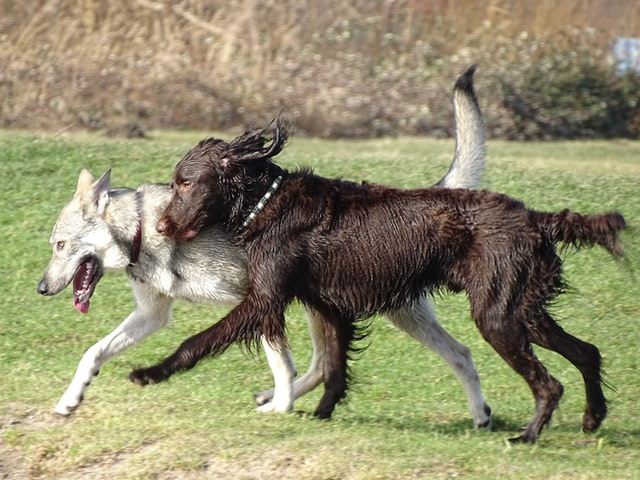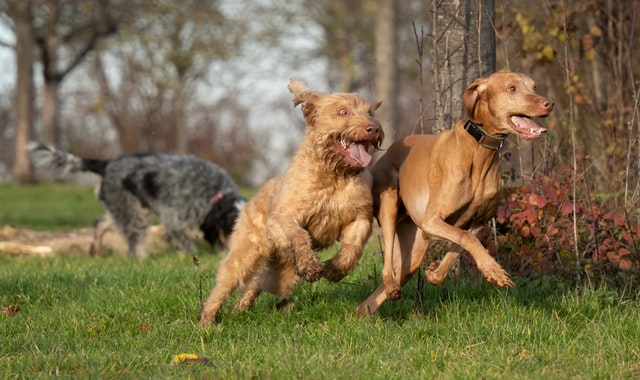10 Most Important Rules of Dog Park Etiquette
Posted: 04/04/2023 | BY: Erin Cain | Categories: Dog , Pet care , Top Tips
Spring is coming, and with the warmer weather comes more outings with your pup. A great way to give your dog some exercise and strengthen her socialization skills is a trip to the local dog park. Dog parks provide plenty of opportunities for positive enrichment, bonding time for you and your dog, and space for off-leash running and playing. However, as a pup parent, you need to be responsible for your dog’s behavior and conduct around other people and dogs. You can make a visit to the dog park a joy for you, your dog, and other canines by following these 7 most important rules of dog park etiquette.

1. Know the rules of the park.
Every dog park has its own rules and regulations. If you take your dog to a new park, make sure you know the specific rules called for in that location. Although many parks have their unique standards, most dog parks ask pup parents to do the following:
- Have your pup vaccinated before attending a dog park. Dogs who attend parks should be current on the following vaccinations: canine influenza, bordetella (kennel cough), and leptospirosis. Your dog should have heartworm, flea, and tick treatment as well.
- Don’t bring your dog to the park if he is intact or she is in heat; dogs not neutered or spayed can act aggressively or cause aggression in other dogs.
- Follow the rules posted at the gate to the park so that you and your dog can safely enter and exit.
- Keep small dogs in the small dog section of the park and large dogs in the large dog section; some dogs are too big to play with their smaller counterparts, and injuries could occur.
- If your dog is showing signs of illness or is not acting like herself, keep her home.
2. Don’t keep your dog on a leash inside the park.
Dog parks often ask pup parents to keep their dog leashed in the doggie gate area and then let their dog off leash when entering the park. You should follow these rules as some dogs become defensive when they are on a leash and the other dogs around them are not. That scenario can lead to aggressiveness and serious injuries. If you don’t trust your dog off-leash, she may not be ready for the dog park yet.
3. Clean up after your dog.
This rule should be a no-brainer, but go to any dog park, and you’ll see that some pup parents aren’t fond of following this rule. Many dog parks offer free waste bags and multiple garbage bins to pick up your dog’s poop, so there’s no excuse not to clean up after your pup. Also, leaving solid waste on the ground is not only gross but also unsanitary. Do your part to keep the park clean and safe by preventing the spread of bacteria and parasites. Poop happens, so grab a bag and clean it up!
4. Leave your puppy at home.
There are numerous reasons that a puppy doesn’t belong in a dog park, the primary one being that a puppy does not yet have all her vaccinations. She can become exposed to parasites and bacteria that her little body is not prepared to fight.
Many puppies are still learning to hone their social skills with other dogs and people. Let your puppy grow up and build that skill set before bringing her into a new area full of strange dogs. Additionally, most puppies are smaller than adult dogs and can be inadvertently injured by them; thus, most veterinarians and trainers recommend that a puppy be at least six months old before attending a dog park.

5. Refresh your pup’s training.
Before you bring your dog to the park, brush up on her training cues. When your dog is off-leash, she should be able to respond to basic commands like “sit,” “stay,” and perhaps most important of all, “come,” or the recall command.
In case of an emergency, you can command your dog to return to you, no matter what else is happening around her. A good recall command can keep your dog safe. If you haven’t worked on these basic commands with your dog lately, start small and practice in your backyard before moving onto a bigger challenge, such as the dog park.
6. Pay attention to behavioral clues.
Always keep an eye on your dog and her body language when you’re at the dog park. Your dog’s facial expressions and posture say a lot more about how she feels than any barks or whines you hear. Learning to read your dog’s body language can ensure that you both have fun at the dog park, but if your dog isn’t feeling it, you’ll know right away and can remove her from an uncomfortable situation. Observe your dog carefully so you can learn what she is “saying” to you through nonverbal body language. That way you will both be on the same page no matter where you go.

7. Know when to leave.
An overtired dog can quickly become a cranky and irritable pup. If you see that your dog is tired out, then it’s time to bring her home. Also, if you see that your dog is overexcited or fearful of another dog, leave the park with her before something unfortunate happens. Always know when to call it a day, and don’t push your dog to stay somewhere when she’s too upset or exhausted to enjoy it anymore.
8. Don’t give treats to other dogs.
Some dog parks allow treats inside. You should feel free to give your own dog a treat or two here and there. But you should never give treats to someone else’s dog that you do not know personally. Even giving your own dog treats while there are other strange dogs around can cause aggression and sudden fighting. Also, some dogs may have food allergies, so best to keep your treats only for your pup and only when you two are alone.
9. Don’t ignore your dog.
Getting to socialize with other dog owners is definitely a big perk of dog parks. But you should never just let your dog off leash and then ignore him for half an hour. Keep an eye on your pup at all times. Dogs can start acting up in an instant and fights can break out.
10. Avoid the 3 Ps.
The 3 Ps stand for packing, possession, provoking. We want to always ensure our dog is happy and safe and so we’ve got to take a few things into consideration. Packing refers to when a group of dogs come together and intimidate other dogs. Dogs tend to become very excited when they form packs and that can lead to fighting.
Possession: watch to be sure your dog has not become possessive of a stick or someone else’s ball. Also, be aware of other dog’s who may be possessive when your dog walks up to them.
And finally, be sure your dog isn’t provoking, meaning they aren’t going after other dogs and causing trouble. Provoking is usually a result of a dog becoming too excited, which can easily happen to dogs at a dog park.
Have a pawsitive park experience!
Dog parks can be fantastic opportunities for your dog to be a dog and to enjoy some off-leash exercise. Following these rules can make an outing to the dog park fun and enriching for you and your dog. It can just as quickly go the wrong way, but you can prevent mishaps and injuries by obeying the park regulations and knowing your dog’s personality.
In case something bad does happen, make sure your pup has a pet insurance policy to help you cover any medical costs. If you don’t have a pet insurance policy, you can get a free quote, and Pet Insurance Review will help you find the right coverage for your dog and your budget.
References:
- American Veterinary Medical Association. (n.d). Canine Influenza: Pet Owners’ Guide. Retrieved from https://www.avma.org/resources/pet-owners/petcare/canine-influenza-pet-owners-guide
- Burke, A. (2017). 5 Facts About the Bordetella Vaccine for Dogs. Retrieved from https://www.akc.org/expert-advice/health/facts-bordetella-vaccine-dogs/
- McCalley, L. (2021). Leptospirosis Vaccine for Dogs. Retrieved from https://www.greatpetcare.com/pet-vaccinations/leptospirosis-vaccine-for-dogs/
- McMullen, D. (2013). Altered States: How Important is Intact Status to Social Skills? Retrieved from http://www.howmanydogs.com/2013/07/how-important-is-intact-status-to-social-skills/
- Burket, R., Burket A. (2021). My Dogs are Afraid of Your Off-Leash Dog. Retrieved from https://www.winnebago.com/lifestyle/winnebagolife/life/my-dogs-are-afraid-of-your-off-leash-dog
- Pajer, N. (2020). Is Dog Poop Hazardous to Your Yard? Retrieved from https://www.petmd.com/dog/pet-lover/dog-poop-hazardous-your-yard
- Anderson, T. (n.d.). Why Puppies and Dog Parks Don’t Mix. Retrieved from (https://moderndogmagazine.com/articles/why-puppies-and-dog-parks-don-t-mix/101482
- Bender, A. (2019). How to Train Your Dog to Come in an Emergency. Retrieved from https://www.thesprucepets.com/teach-dog-emergency-recall-1118240
- Gibeault, S. (2020). Understanding Dog Body Language: Decipher Dogs’ Signs and Signals. Retrieved from https://www.akc.org/expert-advice/advice/how-to-read-dog-body-language/
Disclaimer
The information contained on this blog is intended for informational and educational purposes only and should not be construed as medical advice. It is not a substitute for professional veterinary care. Always consult with your veterinarian before making any changes to your pet's health care or treatment plan.
The authors of this blog are not veterinarians and do not claim to be experts in pet health. The information provided here is based on our own experiences and research, as well as information from reputable sources. However, we cannot guarantee the accuracy or completeness of this information.
We encourage you to do your own research and consult with your veterinarian before making any decisions about your pet's health.
Previous post
How to Comfort a Dog with PancreatitisNext post
How to Calm a Panting DogCompare top pet insurance providers plans.
Enter your dog’s age in years and months to calculate their age equivalent to human years.
Calculate your dog’s ageEnter your cat’s age in years and months to calculate their age equivalent to human years.
Calculate your cat’s age